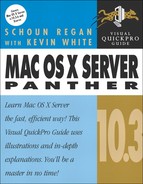Book Description
As the first server platform to let Mac, Unix, and Linux users share files and printers out of the box, Mac OS X Server promises to revolutionize the world of network administration (or at least make it a whole lot easier). Here to make sure you don't get left behind is Mac OS X Server: Visual QuickPro Guide. In this task-based guide, veteran Mac expert Schoun Regan shows you how to manage local networks, navigate the Unix file system permission architecture, and administer Internet and Web services. You'll also explore the ins and outs of IP-based file sharing and printing services and learn about all that's new in the latest of Apple's big cats, Panther Server: improved setup, management, and monitoring capabilities; enhanced Windows integration; new workgroup and desktop management tools; and more. Clear, concise language, step-by-step instructions, and loads of visual aids mean that even beginners can get up to speed on Mac OS X Server--quickly and efficiently--with this guide.
Table of Contents
- Copyright
- Acknowledgments
- Introduction
- 1. Planning and Installation
- 2. Server Tools
- 3. Open Directory
- 4. User and Group Management
- 5. File Sharing
- 6. Network Configuration Options
- 7. Printing Services
- 8. Mail Services
- 9. Web Services
- 10. Security
- 11. Running a NetBoot Server
- 12. QuickTime Streaming Server
- 13. Client Management
- Managing Computer Lists
- Managing Preferences
- The Applications managed preference
- The Classic managed preference
- The Dock managed preference
- The Energy Saver managed preference
- The Finder managed preference
- The Internet managed preference
- The Login managed preference
- The Media Access managed preference
- The Mobile Accounts managed preference
- The Printing managed preference
- The System Preferences managed preference
- The Universal Access managed preference
